By: Donatella Zona, San Diego State University (SDSU) Kyle Lunneberg, SDSU and University of California Davis; and Walter C. Oechel, SDSU
Our research group at San Diego State University has been using eddy covariance (Figure 1) to track Arctic carbon (carbon dioxide) fluxes for over 20 years and methane (methane) fluxes for more than a decade (Zona et al. 2016; Arndt et al. 2019). Eddy covariance is an atmospheric measurement technique to measure and calculate vertical turbulent fluxes within atmospheric boundary layers. Our long-term research, supported by the National Science Foundation (NSF), has been driven by the fact that temperatures in northern latitudes have been increasing at twice the global average (Rantanen et al. 2022). This temperature increase can affect the very large soil carbon reservoir in northern latitude permafrost soils (Hugelius et al. 2014), and exacerbate global warming through releases of carbon dioxide and methane. However, it is impossible to refine predictions on future greenhouse gas (GHG) emissions from the Arctic without long-term carbon dioxide and methane fluxes from tundra ecosystems. Large uncertainties still exist due to the difficulties associated with collecting high-quality flux data in harsh Arctic environments, particularly during the cold season (Figure 2, Goodrich et al. 2016; Zona et al. 2016; Arndt et al. 2019). The scarcity of available continuous eddy covariance data led synthesis and modeling efforts in the Arctic to rely heavily on chamber studies (McGuire et al. 2012; Bohn et al. 2015; Vikkala et al. 2022). Chamber studies are discontinuous, tend to be concentrated in summer, tend to under-sample the heterogeneous nature of the Arctic landscape (Figure 3), and are often collected in different sites in different years (Vikkala et al. 2022) adding to the challenges in reconstructing temporal changes.
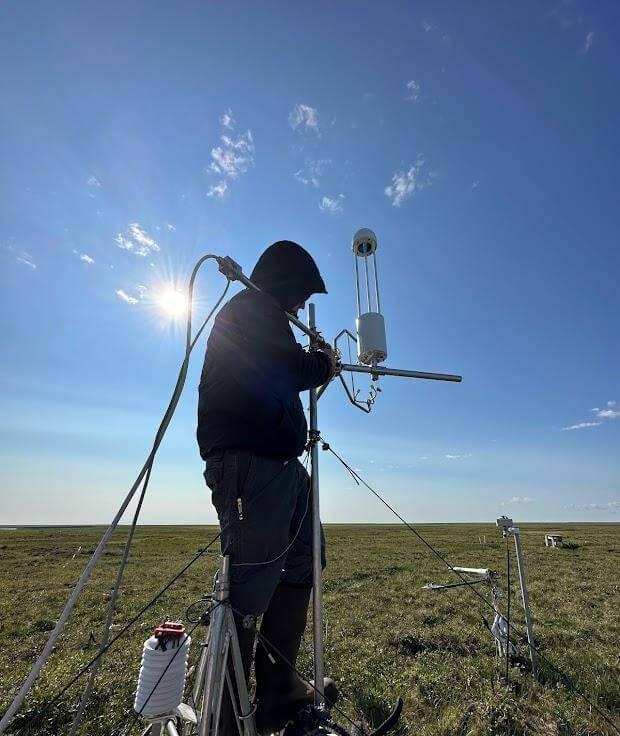
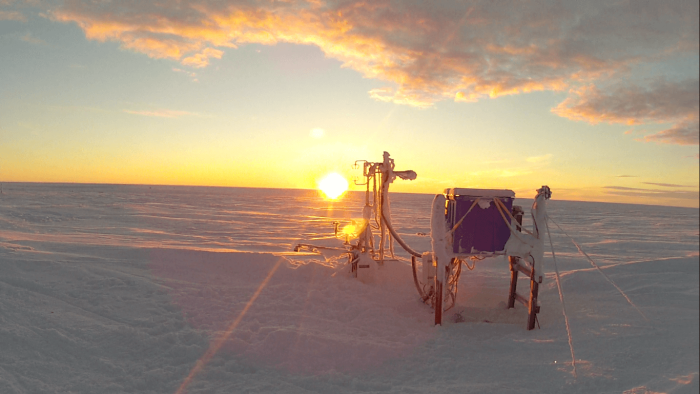
Knowledge of the multi-decadal patterns in GHG fluxes, especially carbon dioxide and methane, is critical to understanding the response to climate variability and long-term change in the carbon balance from the Arctic. Some Arctic ecosystems have shown weakening carbon dioxide sink strength or have already switched from being a long-term sink to a source of carbon dioxide to the atmosphere because of recent climate changes (Gorham 1991; Lund et al. 2012; Oechel et al. 1993, 2000, 2014; Commane et al. 2017), thereby contributing to positive feedback on warming. For example, the North Slope of Alaska seems to have switched in the mid-1970s from a Holocene sink to a source of carbon dioxide to the atmosphere (Oechel et al. 1993, 2000, 2014; Euskirchen et al. 2017; Mauritz et al. 2017). However, other areas across the Arctic have shown enhanced sink strength (Hudson et al. 2011; Elmendorf et al. 2012). A more consistent long-term dataset is therefore critical to properly identify the temporal changes in the carbon balance of these tundra ecosystems.
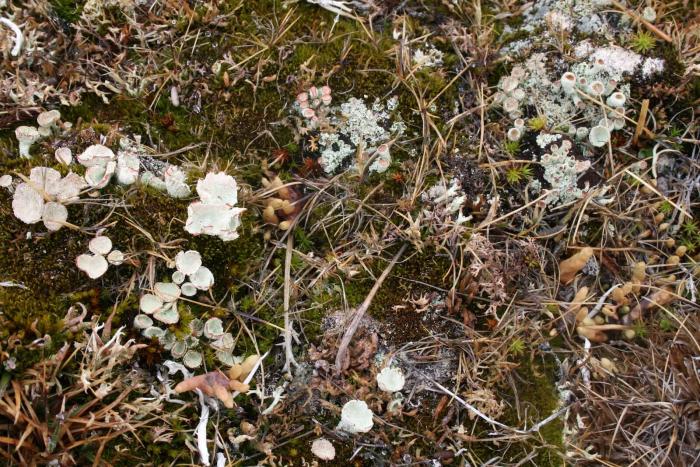
The year-round carbon dioxide and methane fluxes we have been collecting in five eddy covariance towers span a 300 kilometers latitudinal gradient from the Arctic coast in Utqiaġvik to the foothills of the Brooks Range in Ivotuk to the south (Figure 4), including drained and inundated habitats in Utqiaġvik, polygonal tundra in Atqasuk, and upland tundra in Ivotuk. This network encompasses a cross-section of the main ecosystem types occurring in the entire North Slope of Alaska, including the most extensive vegetation and physiognomic types in the Alaskan Arctic: the wet sedge tundra, the tussock tundra, and the dwarf-shrub tundra (see example of tundra vegetation in Figure 3).
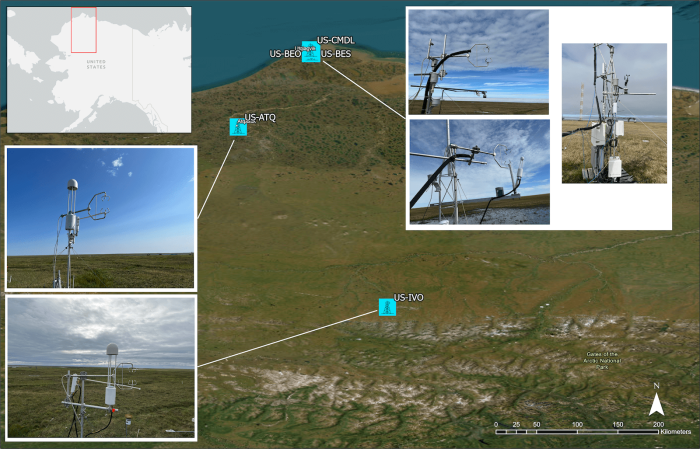
By combining our data with data collected by other research groups across the Arctic (including data from Greenland, Canada, and the Russian Arctic), we have found that earlier snowmelt is associated with more tundra net carbon dioxide sequestration and higher plant productivity only in June and July, but with lower net carbon sequestration and lower plant productivity in August. Our results suggest that the expected increased carbon dioxide sequestration arising from Arctic warming and the associated increase in growing season length may not materialize if tundra ecosystems are not able to continue sequestering carbon dioxide later in the season (Zona et al. 2022). These results changed our assumption of the benefits that earlier snowmelt have on tundra ecosystems across the Arctic by showing that an earlier activation of the ecosystems is also associated with an earlier senescence, contradicting the assumption that the overall summer Arctic tundra carbon uptake will increase with earlier snow disappearance.
We also tested the response of tundra plant productivity and net carbon sequestration to changes in soil moisture, using 100 site-years of data across the Arctic, to identify potential moisture limitations to plant productivity and net carbon exchange. Our results show a decrease in plant productivity with increased temperatures during the peak summer (July), which is the most productive period of the year. This implied that tundra ecosystems might not benefit from increased temperature as much as suggested by several terrestrial biosphere models if decreased soil moisture limits the peak summer plant productivity, reducing the ability of these ecosystems to sequester carbon during the summer (Zona et al. 2023). A more complete list of our research results and publications can be found on the Donatella Zona Google Scholar site.
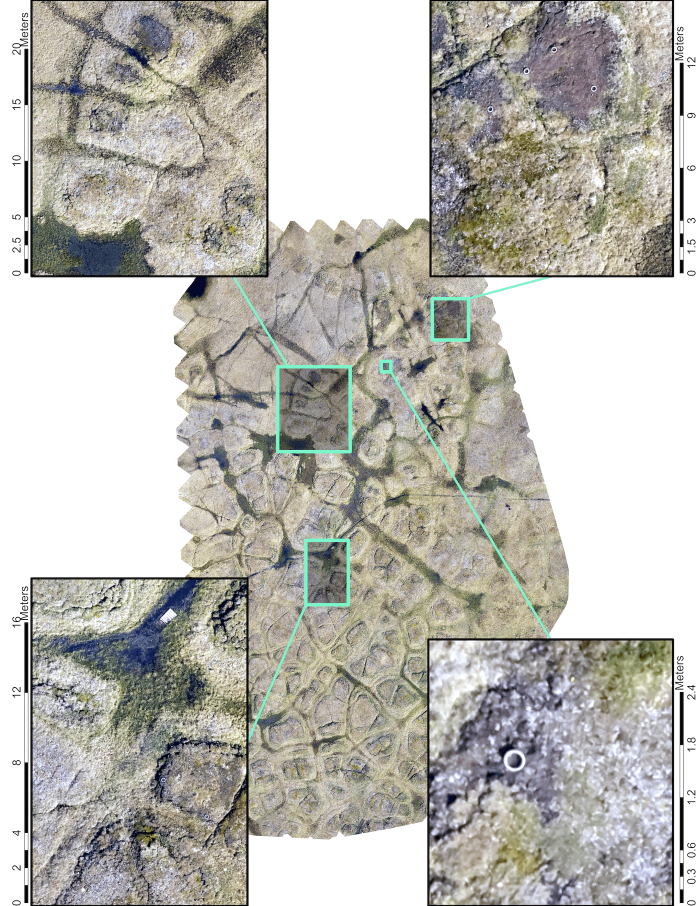
We feel that improving the temporal and spatial coverage of both carbon dioxide and methane flux data is critical to better characterize this complex Arctic landscape and upscale these fluxes to the regional scale (Figure 5). Making these data accessible to the wider Arctic research community is contributing to closing a critical knowledge gap in the current state of Arctic carbon-climate feedback representation in models. There is considerable need for a long-term, year-round measurement program. The long-term dataset collected by this project is made publicly available within six months from collection in the NSF-funded data repository (Arctic Data Center) and has already been downloaded by more than 2,000 users (Zona 2023). We are planning to continue this effort over the next years, as we are now building a time-series long enough to identify the changes in the carbon balance of tundra ecosystems over recent decades and the causes of these changes.
This work has been supported by NSF grants, Multi-Decadal Year-Round carbon dioxide and methane Fluxes to Understand Long-Term Impact of Climate Change on the Arctic Carbon Balance, and Towards Filling a Major Gap in the Greenhouse Gas Balance From the Arctic: Defining the Importance of nitrous oxide Emission in the North Slope of Alaska
References
Arndt, K. A., et al. 2019. Sensitivity of Methane Emissions to Later Soil Freezing in Arctic Tundra Ecosystems. Journal of Geophysical Research: Biogeosciences 124(8): 2595–2609.
Commane, R., J. Lindaas, J. Benmergui, K. A. Luus, R. Y.-W. Chang, B. C. Daube, E. S. Euskirchen, J. M. Henderson, A. Karion, J. B. Miller, S. M. Miller, N. C. Parazoo, J. T. Randerson, C. Sweeney, P. Tans, K. Thoning, S. Veraverbeke, C. E. Miller, and S. C. Wofsy. 2017. Carbon dioxide Sources from Alaska Driven by Increasing Early Winter Respiration from Arctic Tundra. Proceedings of the National Academy of Sciences 114: 5361–5366.
Elmendorf, S. C., et al. (2012). Plot-Scale Evidence of Tundra Vegetation Change and Links to Recent Summer Warming. Nature Climate Change 2(6): 453–457.
Euskirchen, E. S., M. S. Bret-Harte, G. R. Shaver, C. W. Edgar, and V. E. Romanovsky.
2017. Long-Term Release of Carbon dioxide from Arctic Tundra Ecosystems in Alaska. Ecosystems 20(5): 960–974.
Goodrich, J. P., et al. 2016. Impact of Different Eddy Covariance Sensors, Site Set-Up, and Maintenance on the Annual Balance of carbon dioxide and methane in the Harsh Arctic Environment. Agricultural and Forest Meteorology 228–229: 239-251.
Gorham, E. 1991. Northern Peatlands: Role in the Carbon Cycle and Probable Responses to Climatic Warming. Ecological Applications 1(2): 182–195.
Hudson, J. M. G., G. H. R. Henry, and W. K. Cornwell. 2011. Taller and Larger: Shifts in Arctic Tundra Leaf Traits after 16 Years of Experimental Warming. Global Change Biology 17(2): 1013–1021.
Hugelius, G., et al. 2014. Estimated Stocks of Circumpolar Permafrost Carbon with Quantified Uncertainty Ranges and Identified Data Gaps. Biogeosciences 11(23): 6573–6593.
Lund, M., J. M. Falk, T. Friborg, H. N. Mbufong, C. Sigsgaard, H. Soegaard, and M. P. Tamstorf. 2012. Trends in carbon dioxide Exchange in a High Arctic Tundra Heath, 2000-2010. Journal of Geophysical Research: Biogeosciences (2005–2012), 117(G2).
Mauritz, M., R. Bracho, G. Celis, J. Hutchings, S. M. Natali, E. Pegoraro, V. G. Salmon, C. Schädel, E. E. Webb, and E. A. G. Schuur. 2017. Non-linear carbon dioxide Flux Response to Seven Years of Experimentally Induced Permafrost Thaw. Global Change Biology. doi:10.1111/gcb.13661
Oechel, W. C., G. L. Vourlitis, S. J. Hastings, R. C. Zulueta, L. Hinzman, and D. Kane. 2000. Acclimation of Ecosystem carbon dioxide Exchange in the Alaskan Arctic in Response to Decadal Climate Warming. Nature 406: 978–981.
Oechel, W. C., S. J. Hastings, G. Vourlrtis, M. Jenkins, G. Riechers, and N. Grulke. 1993. Recent Change of Arctic Tundra Ecosystems from a Net Carbon dioxide Sink to a Source. Nature 361(6412): 520–523.
Oechel, W. C., C. A. Laskowski, G. Burba, B. Gioli, and A. A. Kalhori. 2014. Annual Patterns and Budget of carbon dioxide Flux in an Arctic Tussock Tundra Ecosystem. Journal of Geophysical Research: Biogeosciences 119(3): 323–339.
Rantanen, M., et al. 2022. The Arctic Has Warmed Nearly Four Times Faster than the Globe since 1979. Communications Earth & Environment 3(1): 168.
Virkkala, A. M., et al. 2022. The ABCflux Database: Arctic–Boreal carbon dioxide Flux Observations and Ancillary Information Aggregated to Monthly Time Steps across Terrestrial Ecosystems. Earth System Science Data 14(1): 179–208.
Zona, D. 2023. Greenhouse Gas Flux Measurements at the Zero Curtain, North Slope, Alaska, 2012–2023. Arctic Data Center. doi:10.18739/A20Z70Z1H, version: urn:uuid:3f939c7e-c672-4cc0-9bde-ae07e2b0238e.
Zona, D., et al. 2023. Pan-Arctic Soil Moisture Control on Tundra Carbon Sequestration and Plant Productivity. Global Change Biology 29: 1267–1281. doi:https://doi.org/10.1111/gcb.16487.
Zona, D., et al. 2022. Earlier Snowmelt May Lead to Late Season Declines in Plant Productivity and Carbon Sequestration in Arctic Tundra Ecosystems. Scientific Reports 12: 3986. doi:10.1038/s41598-022-07561-1
Zona, D., et al. 2016. Cold Season Emissions Dominate the Arctic Tundra Methane Budget. Proceedings of the National Academy of Sciences 113(1): 40-45.
About the Authors
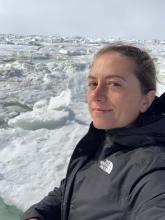 Donatella Zona is a Professor at San Diego State University (SDSU) and leads the Zona Lab at SDSU. Her background integrates the study of the functioning of a variety of ecosystems, natural (Arctic tundra), and managed (oak forest, agro-ecosystems). She is particularly interested in the patterns and controls on non-carbon dioxide gasses such as ozone, methane, nitrous oxide fluxes, whose emissions are very difficult to measure and model. Her main research emphasizes the impact of climate change on biodiversity, ecosystem functioning, and greenhouse gas emission (carbon dioxide and methane) in the Arctic. Her interest ranges from the mechanisms allowing tundra ecosystems to adjust or avoid environmental stress and how climate change affects ecosystem functioning to the importance and the challenges of integrating different scales and approaches to understand the patterns and controls on carbon dioxide and methane fluxes in the Arctic.
Donatella Zona is a Professor at San Diego State University (SDSU) and leads the Zona Lab at SDSU. Her background integrates the study of the functioning of a variety of ecosystems, natural (Arctic tundra), and managed (oak forest, agro-ecosystems). She is particularly interested in the patterns and controls on non-carbon dioxide gasses such as ozone, methane, nitrous oxide fluxes, whose emissions are very difficult to measure and model. Her main research emphasizes the impact of climate change on biodiversity, ecosystem functioning, and greenhouse gas emission (carbon dioxide and methane) in the Arctic. Her interest ranges from the mechanisms allowing tundra ecosystems to adjust or avoid environmental stress and how climate change affects ecosystem functioning to the importance and the challenges of integrating different scales and approaches to understand the patterns and controls on carbon dioxide and methane fluxes in the Arctic.
 Kyle Lunneberg is a postdoctoral researcher at San Diego State University and is on the research team at the Center for Ecosystem Climate Solutions. He has experience in both Arctic and Mediterranean ecosystems, and in combining both remote sensing, flux chamber and eddy covariance techniques to upscale the carbon dioxide and methane fluxes to the regional scale.
Kyle Lunneberg is a postdoctoral researcher at San Diego State University and is on the research team at the Center for Ecosystem Climate Solutions. He has experience in both Arctic and Mediterranean ecosystems, and in combining both remote sensing, flux chamber and eddy covariance techniques to upscale the carbon dioxide and methane fluxes to the regional scale.
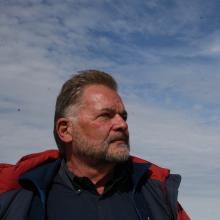 Walter C. Oechel is a Distinguished Professor of Biology, San Diego State University; Coordinator for the Joint Doctoral Program in Ecology with the University of California Davis; Director of the Global Change Research Group; and Academic Director of the Field Stations Program. Oechel's research focuses on developing and understanding the predictive capability of the interconnections of terrestrial, atmospheric, and marine systems on global change. He focuses primarily in the Arctic (Alaska, Russia), the Pacific Basin (Baja California Sur, Mexico, Indonesia), and the semi-arid ecosystems of Italy and San Diego. He incorporates a small research aircraft, eddy covariance towers, soil measurements, remote sensing, and modeling in his research programs.
Walter C. Oechel is a Distinguished Professor of Biology, San Diego State University; Coordinator for the Joint Doctoral Program in Ecology with the University of California Davis; Director of the Global Change Research Group; and Academic Director of the Field Stations Program. Oechel's research focuses on developing and understanding the predictive capability of the interconnections of terrestrial, atmospheric, and marine systems on global change. He focuses primarily in the Arctic (Alaska, Russia), the Pacific Basin (Baja California Sur, Mexico, Indonesia), and the semi-arid ecosystems of Italy and San Diego. He incorporates a small research aircraft, eddy covariance towers, soil measurements, remote sensing, and modeling in his research programs.
